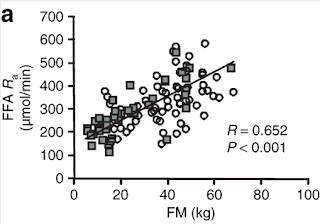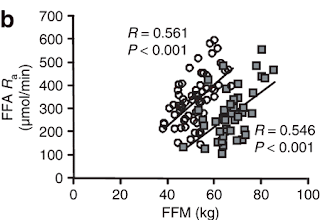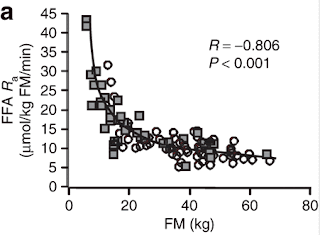Free Fatty Acid Levels and Body Fat Mass
Relationship Between Body Fat Mass and Free Fatty Acid Kinetics in Men and Women
{Hat tip MM, thanks!}
{Hat tip MM, thanks!}
Alterations in free fatty acid (FFA) metabolism are involved in the pathogenesis of insulin resistance, diabetes, dyslipidemia, and cardiovascular disease (1,2). Excessive plasma FFA availability impairs the ability of insulin to suppress hepatic glucose production and to increase skeletal muscle glucose disposal (1,3). Plasma FFAs are also the primary source of fatty acids for hepatic very low-density lipoprotein–triglyceride (TG) production (4,5,6,7), and plasma very low-density lipoprotein–TG concentration is an important risk factor for cardiovascular disease (8,9). In addition, the accumulation of intracellular fatty acid metabolites stimulates the production of inflammatory proteins (10), which can also contribute to insulin resistance and atherosclerosis (1). Therefore, understanding the factors that affect FFA metabolism has important physiological and clinical implications.
I would like to comment on the triglycerides here. In low carbers reduced trig levels are observed and celebrated. The high trigs and NEFA are what are seen for carb consuming folks with IR, MetS or diabetes. The trigs are a biomarker associated with athero and such, but I've not come across too many studies of a DIRECT effect caused by elevated trigs as I have with elevated NEFA. Therefore it MAY be premature to celebrate over the reduced trigs in low carbers.
It has been hypothesized that the metabolic complications associated with obesity are due to increased body fat mass (FM), which increases the release of FFA into plasma. However, the relationship between body fat and FFA metabolism is unclear because of conflicting results from different studies. For example, the rate of FFA release into plasma, expressed per unit of fat-free mass (FFM), in obese subjects has been reported to be both greater than (11,12,13,14,15) and the same as (5,13,16,17) the rate of FFA release in lean subjects. The relationship between adiposity and FFA metabolism is further complicated by sex because, at any given BMI, women have more fat than men (18). An adequate evaluation of the influence of sex and adiposity on FFA metabolism is difficult, because it requires conducting careful metabolic studies in a large number of subjects.
The purpose of the present study was to provide a definitive evaluation of the inter-relationships between body composition, sex, and FFA kinetics by studying a large sample of men and women who had a wide range in percent body fat, but who did not have diabetes or other metabolic abnormalities that could confound the interpretation of the data.Here are the results: FM = fat mass FFM = fat free mass Squares = men Circles = women
- The rate of FFA release into plasma per unit of FM is the same in men and women
- The total FFA Ra in relationship to FFM is greater in women than men, because women have more body fat than men.
- Total FFA Ra and FFA Ra per unit of FFM increase with increasing adiposity
- FFA release per unit of FM decreases in a curvilinear fashion with increasing body fat.
- Obesity is associated with a decrease in the rate of FFA release from adipose tissue.
- The downregulation in the rate of FFA release per unit of body fat does not completely compensate for the increase in total body fat
- Total FFA Ra and FFA availability in relation to FFM are increased in the obese.
- Abdominal fat distribution does not have an important independent influence on FFA kinetics.
This one was a surprise given the association of MetS with abdominal obesity. But both subQ and intra-abdominal fat correlated with total fat. The key word above is independent. Still:
- Total body FM as the single best determinant of both total FFA Ra and FFA Ra per kg FFM in men (r = 0.791 and 0.714, respectively, P < 0.001) and intra-abdominal FM as the single best predictor of both total FFA Ra and FFA Ra per kg FFM in women (r = 0.648 and r = 0.524, respectively; P <0.001).
- These data underscore the importance of total body FM in regulating the basal FFA flux.
This study again shows that the obese do NOT have their fats locked away in adipocytes unavailable for fat burning as is the common claim made by those adhering to insulin-centric theories on obesity.




Comments
http://plover.net/~bonds/adhominem.html
I’m glad you touch on the confusing relationship between trigs and NEFA. Low (or decreasing) triglycerides are at the very least associated with increased insulin sensitivity and glucose tolereance and, for what it’s worth, with a ‘non atherogenic’ lipoprotein profile. From my own observations I would say that in the wild population, decreasing trigs in people introducing a diet or exercise routine usually go together with a bunch of ‘other improved’ parameters (>HDL, Heart Rate Variability, one of the best windows on ANS-function). On the other hand, I’m convinced elevated NEFA are detrimental, if only because Malcolm Kendrick uses to say it’s fat that does us in (kills our beta cells), not glucose. He is seldom wrong. He likes to point to the humble Humming bird, which is humming along just fine with a steady blood glucose of 23,3 mmol/l ;-).
I know this is an impossible question, but do you think decreasing trigs automatically mean increasing NEFA plus all the potential downstream mayhem? From the sometimes impressive health improvements seen in people going paleo, I would guess this is not the case.
I'm curious about Malcolm Kendrick's comments on elevated NEFA. Do you have a link you can share? Thanks.
I know this is an impossible question, but do you think decreasing trigs automatically mean increasing NEFA plus all the potential downstream mayhem? From the sometimes impressive health improvements seen in people going paleo, I would guess this is not the case.
I don't know really. I posted a while back how NEFA correlates with LDL in low carbers, so if someone sees improvements in both LDL and trigs the NEFA may have corrected itself. I believe many of the dramatic improvements seen "going Paleo" are due to cutting grains from the diet and substantial weight loss.
But I'm not sure about the long run. Unfortunately there really aren't a whole lot of people sharing verifiable information who have consistently followed paleo-styled plans. I've gotten a fair number of emails from folks who have fallen out of favor with such diets after great initial success. I've seen avid low carbers progress towards diabetes and I gotta suspect the NEFA at that point is still around. The LC web is littered with "cured" diabetics who are off glycemic control meds after losing weight and low carbing, but who lose total control of their blood sugar if they eat a bowl of rice. And yet if almost 85% of full-fledged diabetics undergoing gastric bypass surgery have their diabetes all but disappear within days, this tells me this is largely reversible. IOW, there is no need, IMO, to go down that road of greater and greater intolerance to carbs.
Post a Comment
Comment Moderation is ON ... I will NOT be routinely reviewing or publishing comments at this time..